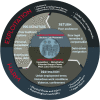Paper: violence, abuse and exploitation among trafficked women and girls: a mixed-methods study in Nigeria and Uganda
- PMID: 35448985
- PMCID: PMC9022300
- DOI: 10.1186/s12889-022-13021-2
Paper: violence, abuse and exploitation among trafficked women and girls: a mixed-methods study in Nigeria and Uganda
Abstract
Background: Africa is the global region where modern-slavery is most prevalent, especially among women and girls. Despite the severe health consequences of human trafficking, evidence on the risks and experiences of trafficked adolescents and young women is scarce for the region. This paper addresses this gap by exploring the intersections between violence, migration and exploitation among girls and young women identified as trafficking survivors in Nigeria and Uganda.
Methods: We conducted secondary analysis of the largest routine dataset on human trafficking survivors. We used descriptive statistics to report the experiences of female survivors younger than 25 years-old from Nigeria and Uganda. We also conducted 16 semi-structured interviews with adolescents identified as trafficked in both countries. We used thematic analysis to explore participants' perceptions and experiences before, during and after the trafficking situation.
Results: Young female survivors of human trafficking in Nigeria and Uganda are exposed to a range of experiences of violence before migration, during transit and at destination. The qualitative data revealed that children and adolescents migrated to escape family poverty, violence and neglect. They had very low levels of education and most had their studies interrupted before migrating. Family members and close social contacts were the most common intermediaries for their migration. During transit, sexual violence and hunger were common, especially among Nigerians. Participants in both the quantitative and qualitative studies reported high levels of violence, deception, coercion, withheld wages and poor working conditions at destination. The adolescents interviewed in the qualitative study reported severe mental suffering, including suicide attempts. Only one reported the prosecution of perpetrators.
Conclusions: Our findings suggest that interventions to prevent or mitigate the negative impact of adverse childhood experiences can contribute to preventing the trafficking of adolescents in Nigeria and Uganda. These interventions include social protection mechanisms, universal access to education, social service referrals and education of parents and carers. Importantly, effective prevention also needs to address the systemic conditions that makes trafficking of female adolescents invisible, profitable and inconsequential for perpetrators.
Keywords: Adolescents; Africa; Human trafficking; Migration; Mixed-methods; Modern-slavery; Violence.
© 2022. The Author(s).
Conflict of interest statement
The authors declare that they have no competing interests.
Figures
Similar articles
-
Exploitation, Violence, and Suicide Risk Among Child and Adolescent Survivors of Human Trafficking in the Greater Mekong Subregion.JAMA Pediatr. 2015 Sep;169(9):e152278. doi: 10.1001/jamapediatrics.2015.2278. Epub 2015 Sep 8. JAMA Pediatr. 2015. PMID: 26348864
-
"She was willing to send me there": Intrafamilial child sexual abuse, exploitation and trafficking of boys.Child Abuse Negl. 2023 Aug;142(Pt 2):105849. doi: 10.1016/j.chiabu.2022.105849. Epub 2022 Nov 8. Child Abuse Negl. 2023. PMID: 36369043
-
Mental health, violence and psychological coercion among female and male trafficking survivors in the greater Mekong sub-region: a cross-sectional study.BMC Psychol. 2018 Dec 12;6(1):56. doi: 10.1186/s40359-018-0269-5. BMC Psychol. 2018. PMID: 30541612 Free PMC article.
-
What do we know about how children and adolescents conceptualise violence? A systematic review and meta-synthesis of qualitative studies from sub-Saharan Africa.PLoS One. 2024 Jul 5;19(7):e0304240. doi: 10.1371/journal.pone.0304240. eCollection 2024. PLoS One. 2024. PMID: 38968312 Free PMC article.
-
Sexual violence against women: the scope of the problem.Best Pract Res Clin Obstet Gynaecol. 2013 Feb;27(1):3-13. doi: 10.1016/j.bpobgyn.2012.08.002. Epub 2012 Aug 29. Best Pract Res Clin Obstet Gynaecol. 2013. PMID: 22940107 Review.
Cited by
-
Factors Influencing Domestic Human Trafficking in Africa: Protocol for a Scoping Review.JMIR Res Protoc. 2024 Nov 18;13:e56392. doi: 10.2196/56392. JMIR Res Protoc. 2024. PMID: 39556420 Free PMC article.
-
Human trafficking risk factors, health impacts, and opportunities for intervention in Uganda: a qualitative analysis.Glob Health Res Policy. 2023 Dec 11;8(1):52. doi: 10.1186/s41256-023-00332-z. Glob Health Res Policy. 2023. PMID: 38072964 Free PMC article.
References
-
- International Labour Office (ILO): Global estimates of modern slavery: Forced labour and forced marriage. In.; 2017.
-
- United Nations Global Assembly (UNGA): Optional Protocol to Prevent, Suppress and Punish Trafficking in Persons, Especially Women and Children, Supplementing the United Nations Convention Against Transnational Organized Crime. In. Edited by UNGA, vol. Res 55/25; 2000.
-
- Skrivankova K: Between decent work and forced labour: examining the continuum of exploitation. York: Joseph Rowntree Foundation 2010.
-
- Ottisova L, Hemmings S, Howard LM, Zimmerman C, Oram S. Prevalence and risk of violence and the mental, physical and sexual health problems associated with human trafficking: an updated systematic review. Epidemiol Psychiatric Sci. 2016;25(4):317–341. doi: 10.1017/S2045796016000135. - DOI - PMC - PubMed
Publication types
MeSH terms
LinkOut - more resources
Full Text Sources
Medical
Miscellaneous


